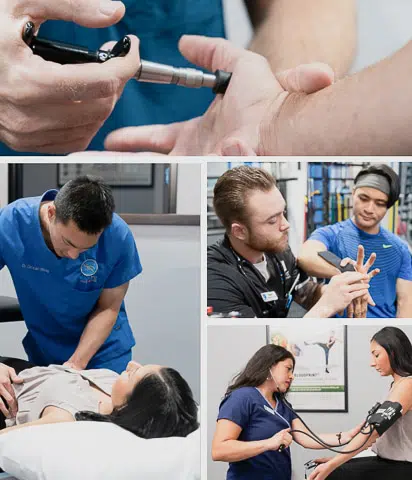Vertigo

Appointment Inquiries
Call us at: (877) 222-5348
Definition
A sudden sentation that you , or the environment around you, is moving or spinning.
Root Causes
Disorientation, Dizziness, Headache, Hearing loss, Nausea, Poor Balance, Swaying, Tilting, Vomiting
Risk Factors
Abuse Alcohol, Age, Family History, Gender, Smoking
Treatments
Chiropractic, Neurologic Physical Therapy, The Epley Maneuver
What is vertigo?
Vertigo is a sudden spinning sensation or feeling dizzy. It creates a false sense that you or your surroundings are moving in a circle. It is often accompanied by disorientation, balance problems, and nausea. Vertigo feels similar to motion sickness.
Other symptoms of vertigo also include tilting, swaying, or the feeling of being pulled in one direction. Extreme cases can be accompanied by vomiting, jerking eye movements, headache, sweating, and ringing in the ears or hearing loss. Related symptoms can last a few minutes or a few hours, and they may come and go.
It can feel like lightheadedness, but it is not the same. It is also often incorrectly used to describe a person with fear of heights. While vertigo can occur from looking down from a great height, it is not the same as acrophobia.
Giddiness is often used to describe dizziness; however, vertigo specifically refers to the spinning feeling that is not related to giddiness.
Vertigo can be temporary or long-term. It is not a condition or illness but a symptom. Many different conditions can cause vertigo.
What causes vertigo?
There are two main types of vertigo: central and peripheral.
Peripheral vertigo is the more common type with over 80% of cases. It is usually sudden, severe, and worsened by certain positions. Tinnitus (ringing of the ears) or hearing loss is also common. It usually lasts seconds to hours or days.
Central vertigo can be gradual or sudden but is usually mild, does not become better or worse by body position, and is usually associated with other neurological symptoms. It usually lasts weeks or months, but can be seconds or minutes in some cases.
Diagnosing between the central and peripheral vertigo is completed with a physical examination. It is usually confirmed with an eye movement test, but imaging may be ordered to further diagnose and eliminate other conditions.
Peripheral vertigo is most often triggered by a change in the position of your head or sudden neck or head movements. This is known as Benign Paroxysmal Positional Vertigo (BPPV). Episodes of BPPV are triggered when the calcium carbonate crystals in your ear become dislodged and fall into the ear canal. When these crystals get lodged in the semicircular canals of the vestibular organ, it can cause BPPV.
BPPV is the most common cause of vertigo. Along with spinning dizziness, it often causes nausea, vomiting, and vision problems. It usually lasts for less than a minute, but some symptoms of BPPV may last days or weeks.
More serious conditions that cause different forms of vertigo include:
- Cervical vertigo (also called cervicogenic dizziness) occurs specifically with neck pain. It may also be accompanied by headaches, nausea, tinnitus, balance problems, muscle weakness, and problems concentrating. It usually lasts minutes to hours.
- Meniere’s disease’s exact cause is unclear, but it occurs when fluid builds up and causes problems in your inner ear. It can cause dizziness, ringing in the ears, and hearing loss. It usually lasts several hours.
- Vestibular migraine symptoms may or may not include a throbbing headache on one side of the head, nausea, sensitivity to light, smell, and noise, dizziness, and balance problems. It may also be accompanied by visual auras. There is almost always a history of motion sensitivity. They usually last minutes to hours but can go on for days.
- Vestibular neuritis and labyrinthitis is inflammation of the vestibular nerve in the vestibular system, specifically in the inner ear. It is usually caused by a viral ear infection that can cause intense, constant vertigo.
Other causes of vertigo include blood flow problems to your inner ear, whiplash or head trauma, shingles, stroke, multiple sclerosis, diabetes, and certain medications. Pregnant women also commonly report vertigo.
Some vertigo has no known cause but may still be treatable.
Risk factors for vertigo
Vertigo can affect anyone, however it is more common with:
- Alcoholism
- Family history
- Older adults (over 50)
- Smokers
- Women
Certain medications also increase your risk. This includes some anti-seizure medication, antidepressants, and aspirin. Also, while dizziness can be a side effect of some blood pressure medications, it is not caused by high blood pressure.
If your current medication(s) cause dizziness, talk to your doctor about it.
Treatments for vertigo
Vertigo is very treatable and often curable. Some types of vertigo resolve without treatment, but if there’s an underlying problem, treatment may be needed. For bacterial infections, antibiotics may be prescribed. For shingles or other viruses, an antiviral may be prescribed.
Until you receive treatment, we also recommend that you:
- Drink plenty of water and stay hydrated.
- Avoid caffeine, salt, alcohol, and tobacco.
- Sit down immediately when dizziness appears.
- Pull over immediately if you are driving.
- Take extra time standing up, looking up, and turning your head.
- Squat instead of bending over to reach the floor.
- Turn lights on at night when getting up to prevent falls.
- Lie down in a quiet, dark room if it gets very bad.
If you fall regularly, you may want to fall-proof your home. In moderate to severe cases, you should also consider not driving, using heavy machinery, or partaking in activities that require you to climb.
Immediately seek medical attention if you develop a fever, have vision or hearing problems, difficulty speaking, feel weakness in your arms or legs, have difficulty walking, have dizziness with headaches, have trouble with daily tasks, or any of the symptoms are getting worse.
Treatment at BackFit Health + Spine may also include:
- Chiropractic care can play an important role in aligning the cervical spine. Chiropractic adjustments work to relieve pressure on the nervous system so that it can better provide sensory input and balance.
- Neurologic physical therapy for vertigo with a board-certified physical therapist. Vestibular rehabilitation is an exercise-based approach to improve balance and reduce dizziness. It may include:
- Vision stabilization
- Posture training
- Stretching and strengthening
- Balance retraining
- Walking/gait exercises
- Neck mobility
- Ergonomics information
- The Epley Maneuver moves the head and body to shift the crystals in the inner ear. Also called canalith repositioning, it is specifically useful for many cases of BPPV.
If symptoms are not eliminated or reduced quickly, motion sickness prescriptions called antiemetics may also be prescribed to reduce nausea. Antihistamines can also relieve symptoms but are not a cure. In extreme cases surgery may also be an option.
Most people don’t have to live and suffer from vertigo. If you think you have episodes of vertigo or you know someone that might, treatment plans are available.
More About BackFit
Looking to learn more? Explore our locations, treatments, or our new patient offer below or contact one of the BackFit Family of staff to have your questions answered.


